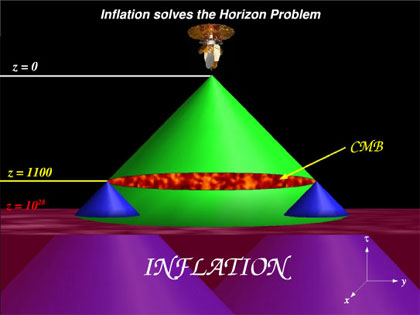
Horizon Problem
Image: the dark blue light cones do not intersect in a universe without inflation, but they do given inflation. Note that the vertical time scale is logarithmic.
Credit: Will Kinney
The Cosmic Microwave Background displays a uniformity of temperature, varying by just one part in a hundred thousand. This indicates that all regions have been in contact with one another some time in the past. However, if when traced back to the big bang using Einstein's equations these regions appear to have always been separated – outside of one another's past causal horizons, being more than a million light-years apart when the universe was only 400,000 years old. This problem is known as the horizon problem, and was first identified by Cjharles Misner in the 1960's.
The horizon problem has motivated many theoretical models explaining how either the regions came into contact, or were in an initial state such that their properties were similar. Cosmic inflation, a rapid expansion of the early universe is one such attempt. Others include past extensions of relativity and specialized initial conditions.
Links
Outline of problem from Trodden and Carroll >
Horizon and Flatness simply explained >

